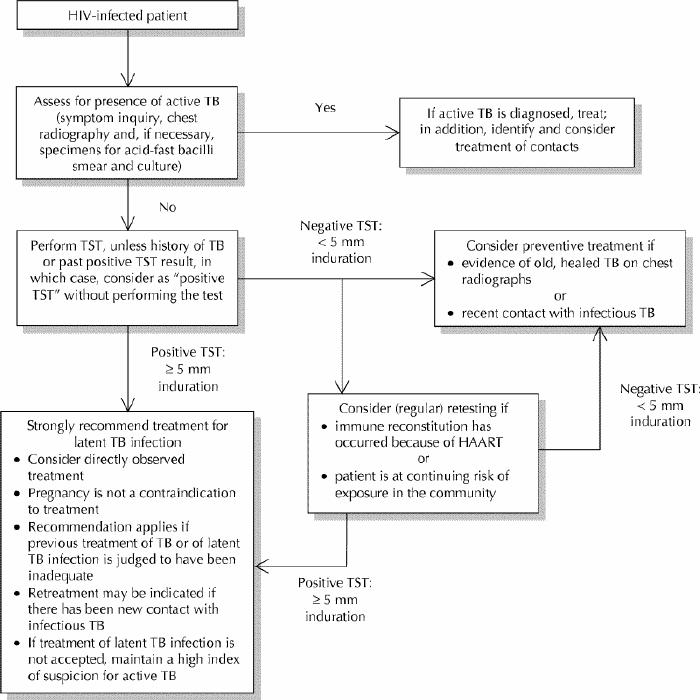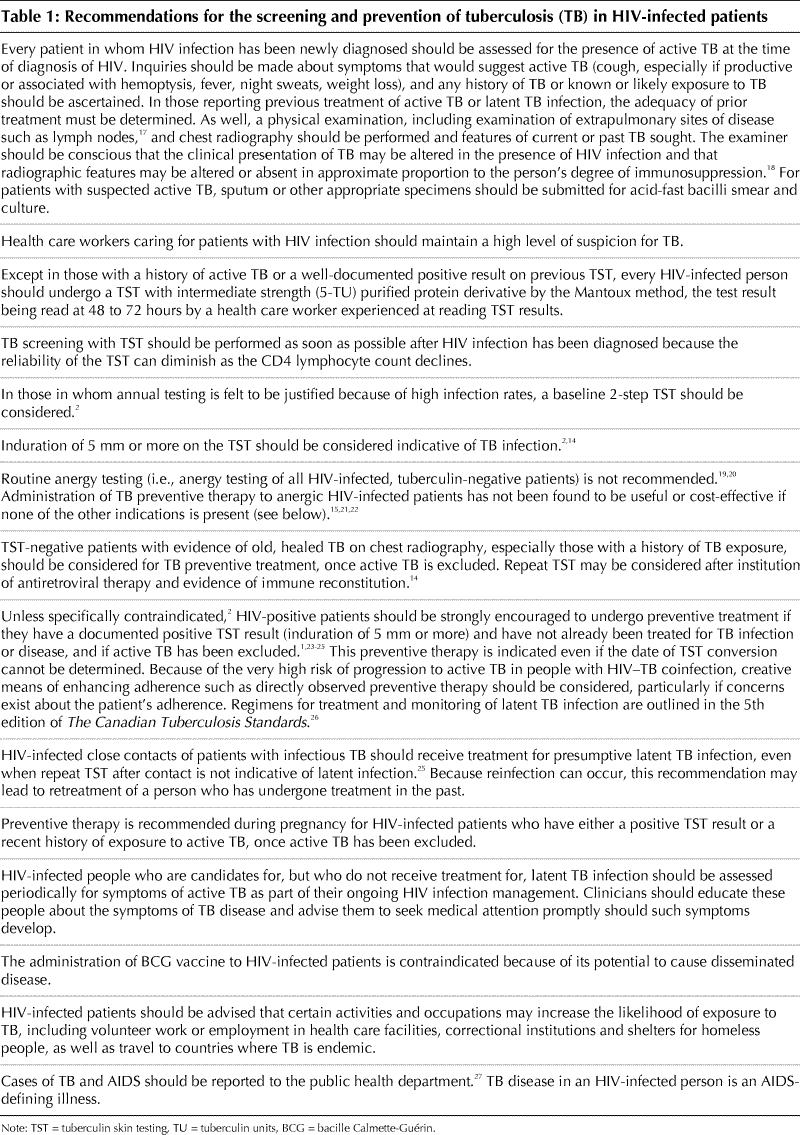The HIV epidemic has had a dramatic impact on rates of tuberculosis (TB) and on TB control in populations where both infections are prevalent.1 HIV infection, in particular advanced HIV infection (AIDS), is more potent than any other risk factor for the progression to disease of recent or remotely acquired TB infection.2 It destroys or renders ineffectual the 2 immune cells most important to the containment of tubercle bacilli, macrophages and CD4 receptor bearing lymphocytes.3 Among people coinfected with Mycobacterium tuberculosis and HIV before availability of highly active antiretroviral therapy, the estimated risk of active TB relative to patients with no other known risk factor for active TB was 170.0 times greater for AIDS and 113.0 times greater for HIV infection without AIDS.2 Cases of reactivation TB attributable to HIV infection increase the risk of transmission of M. tuberculosis within the community, thereby constituting a second, indirect mechanism by which HIV increases TB morbidity.4
In Canada, dormant or latent TB infection is most common in 4 groups: foreign-born people from countries where TB is endemic, Aboriginals, the inner-city poor and homeless, and elderly people.5 Coinfection with HIV is common among inner-city people with a history of injection drug use,6 and recent data suggest that HIV/AIDS is increasing among Aboriginals6,7,8 and among foreign-born people from countries where TB is endemic.9 Treatment of latent TB infection reduces the risk of progression to active disease in people with HIV–TB coinfection.10,11
Patients with TB constitute an important “sentinel” population for HIV screening. In some African countries with high TB prevalence, the prevalence of HIV among TB patients exceeds 70%.12 In the United States, between 1985 and 1992, TB patients were 204–fold more likely to have AIDS than the general population.13 The benefits of identifying previously unrecognized HIV infection are substantial, in terms of both preventing future HIV transmission and providing antiretroviral therapy to affected patients.14 Knowledge of the HIV serostatus of TB patients may also influence the treatment of their TB.15 Even among those not receiving antiretroviral therapy there may be an increased risk of adverse reactions from anti-TB drugs.16 Because HIV-infected patients are at risk of peripheral neuropathy, coadministration of pyridoxine with isoniazid may be prudent. Some HIV-infected TB patients have reportedly experienced malabsorption of their anti-TB drugs, so measurement of serum drug levels may be necessary if there is a poor response to treatment.14
It is thus important to identify and treat active TB or latent TB infection in HIV-infected people (as outlined in Fig. 1 and Table 1) and HIV infection in those with TB (as in Table 2).

Fig. 1: Screening and prevention of tuberculosis in HIV-infected patients. TST = tuberculin skin testing, HAART = highly active antiretroviral therapy.
Table 1

Table 2

Health care providers, administrators and those involved in TB control should strive to promote coordinated care for patients with TB and HIV and to improve information-sharing between TB control programs and HIV/AIDS programs.
These recommendations were prepared by the authors for the Canadian Tuberculosis Committee. The recommendations have been approved by the Centre for Infectious Disease Prevention and Control, Population and Public Health Branch, Health Canada; the Canadian Thoracic Society of the Canadian Lung Association; and the Canadian Infectious Disease Society. They were first published in the Canada Communicable Disease Report.32
Acknowledgments
We thank members of the Centre for Infectious Disease Prevention and Control, Population and Public Health Branch, Health Canada, including the Canadian Tuberculosis Committee, as well as the Canadian Thoracic Society and the Canadian Infectious Disease Society, for their critical review and ultimate approval of these recommendations. We also thank Sue Falconer for secretarial assistance.
Footnotes
This article has been peer reviewed.
Contributors: Dr. Long prepared the initial draft of the article. Drs. Houston and Hershfield critically reviewed the article for revision.
Competing interests: None declared.
Correspondence to: Dr. Richard Long, Department of Medicine, University of Alberta Hospital, Rm. 2E4.21, Walter C. Mackenzie Health Sciences Centre, 8440–112 St., Edmonton AB T6G 2B7; fax 780 407-6384; richard.long@ualberta.ca
References
- 1.Cantwell MF, Binkin NJ. Tuberculosis in sub-Saharan Africa: a regional assessment of the impact of the human immunodeficiency virus and National Tuberculosis Control Program quality. Tuber Lung Dis 1996;77:220-5. [DOI] [PubMed]
- 2.Menzies D, Pourier L. Diagnosis of tuberculosis infection and disease. In: Long R, editor. The Canadian tuberculosis standards. 5th ed. Ottawa: Canadian Lung Association and Health Canada; 2000. p. 45-65. Available: www.lung.ca/tb/TBStandards_Eng.pdf (accessed 2003 Aug 16).
- 3.Beck JM, Shellito J. Effect of human immunodeficiency virus on pulmonary host defenses. Semin Respir Infect 1989;4(2):75-84. [PubMed]
- 4.Narain JP, Raviglione MC, Kochi A. HIV-associated tuberculosis in developing countries: epidemiology and strategies for prevention. Tuber Lung Dis 1992; 73:311-21. [DOI] [PubMed]
- 5.Long R, Njoo H, Hershfield E. Tuberculosis: 3. Epidemiology of the disease in Canada. CMAJ 1999;160(8):1185-90. [PMC free article] [PubMed]
- 6.Blenkush MF, Korzeniewska-Kozela M, Elwood RK, Black W, FitzGerald JM. HIV-related tuberculosis in British Columbia: indications of a rise in prevalence and a change in risk groups. Clin Invest Med 1996;19:271-8. [PubMed]
- 7.Calzavara LM, Bullock S, Myers T, Marshall VW, Cockerill R. Sexual partnering and risk of HIV/STD among Aboriginals. Can J Public Health 1999;90:186-91. [DOI] [PMC free article] [PubMed]
- 8.Health Canada, Centre for Infectious Disease Prevention and Control. HIV/AIDS Epi Update. HIV/AIDS among Aboriginal persons in Canada remains a pressing issue. Ottawa: Health Canada; 2001.
- 9.Health Canada, Centre for Infectious Disease Prevention and Control. HIV/AIDS Epi Update. AIDS/HIV ethnicity in Canada. Ottawa: Health Canada; 2001.
- 10.Wilkinson D, Squire SB, Garner P. Effect of preventive treatment for tuberculosis in adults infected with HIV: a systematic review of randomized placebo controlled trials. BMJ 1998;317:625-8. [DOI] [PMC free article] [PubMed]
- 11.Bucher HC, Griffith LE, Guyatt GH, Sudre P, Naef M, Sendi P, et al. Isoniazid prophylaxis for tuberculosis in HIV infection: a meta-analysis of randomized controlled trials. AIDS 1999;13:501-8. [DOI] [PubMed]
- 12.Dye C, Scheele S, Dolin P, Pathania V, Raviglione M, for the WHO Global Surveillance and Monitoring Project. Global burden of tuberculosis. Estimated incidence, prevalence and mortality by country. JAMA 1999;282:677-86. [DOI] [PubMed]
- 13.Cantwell MF, Snider DE, Cauthen GM, Onorato IM. Epidemiology of tuberculosis in the United States, 1985 through 1992. JAMA 1994;272:535-9. [PubMed]
- 14.Houston S, Schwartzman K, Brassard P, Avendano M, Long R. Tuberculosis and human immunodeficiency virus. In: Long R, editor. The Canadian tuberculosis standards. 5th ed. Ottawa: Canadian Lung Association and Health Canada; 2000. p. 141-51. Available: www.lung.ca/tb/TBStandards_Eng.pdf (accessed 2003 Aug 16).
- 15.Centers for Disease Control and Prevention. Prevention and treatment of tuberculosis among patients infected with human immunodeficiency virus: principles of therapy and revised recommendations. MMWR Recomm Rep 1998;47 (RR-20):1-51. [PubMed]
- 16.Ungo JR, Jones D, Ashkin D, Hollender ES, Bernstein D, Albanese AP, et al. Antituberculosis drug induced hepatotoxicity: the role of hepatitis C and the human immunodeficiency virus. Am J Respir Crit Care Med 1998;157:1871-6. [DOI] [PubMed]
- 17.Korzeniewska-Kosela M, FitzGerald JM, Vedal S, Allen EA, Schechter MT, Lawson L, et al. Spectrum of tuberculosis in patients with HIV infection in British Columbia: report of 40 cases. CMAJ 1992;146(11):1927-34. [PMC free article] [PubMed]
- 18.Jones BE, Young SM, Antoniskis D, Davidson PT, Kramer F, Barnes PF. Relationship of the manifestations of tuberculosis to CD4 cell counts in patients with human immunodeficiency virus infection. Am Rev Respir Dis 1993; 148: 1292-7. [DOI] [PubMed]
- 19.Centers for Disease Control and Prevention. Anergy skin testing and tuberculosis preventive therapy for HIV-infected persons: revised recommendations [published erratum appears in MMWR Morb Mortal Wkly Rep 1997; 46 (37): 880]. MMWR Recomm Rep 1997;46(RR-15):1-10. [PubMed]
- 20.Slovis BS, Plitman JD, Haas DW. The case against anergy testing as routine adjunct to tuberculin skin testing. JAMA 2000;283:2003-7. [DOI] [PubMed]
- 21.Whalen CC, Johnson JL, Okwera A, Hom DL, Huebner R, Mugyenyi P, et al. A trial of three regimens to prevent tuberculosis in Ugandan adults infected with human immunodeficiency virus. Uganda–Case Western Reserve University Research Collaboration. N Engl J Med 1997;337:801-8. [DOI] [PubMed]
- 22.Gordin FM, Matts JP, Miller C, Brown LS, Hafner R, John SL, et al. A controlled trial of isoniazid in persons with anergy and human immunodeficiency virus infection who are at high risk for tuberculosis. Terry Beirn Community Programs for Clinical Research on AIDS. NEngl J Med 1997;337:315-20. [DOI] [PubMed]
- 23.1997 USPHS/IDSA guidelines for the prevention of opportunistic infections in persons infected with human immunodeficiency virus. USPHS/IDSA Prevention of Opportunistic Infections Working Group. MMWR Recomm Rep 1997;46(RR-12):1-46. [PubMed]
- 24.DeRiemer K, Daley CL, Reingold AL. Preventing tuberculosis among HIV-infected persons: a survey of physicians' knowledge and practices. Prev Med 1999; 28:437-44. [DOI] [PubMed]
- 25.American Thoracic Society. Targeted tuberculin testing and treatment of latent tuberculosis infection. Am J Respir Crit Care Med 2000;161(4 Pt 2):S221-47. [DOI] [PubMed]
- 26.Hoeppner V, Marciniuk D. Treatment of tuberculosis disease and infection. In: Long R, editor. The Canadian tuberculosis standards. 5th ed. Ottawa: Canadian Lung Association and Health Canada; 2000. p. 83-109. Available: www.lung.ca/tb/TBStandards_Eng.pdf (accessed 2003 Aug 16).
- 27.Brassard P, Remis RS. Incidence of tuberculosis among reported AIDS cases in Quebec from 1979 to 1996. CMAJ 1999;160(13):1838-42. [PMC free article] [PubMed]
- 28.Expert Working Group on HIV Testing. Counselling guidelines for HIVtesting. Ottawa: Canadian Medical Association; 1995.
- 29.Rowan MS, Toombs M, Bally G, Walters DJ, Henderson J. Qualitative evaluation of the Canadian Medical Association's counselling guidelines for HIV serologic testing. CMAJ 1996;154(5):665-71. [PMC free article] [PubMed]
- 30.Missed opportunities for prevention of tuberculosis among persons with HIV infection — selected locations, United States, 1996–1997. MMWR Morb Mortal Wkly Rep 2000;49(30):685-7. [PubMed]
- 31.Marks SM, Taylor Z, Qualls NL, Shrestha-Kuwahara RJ, Wilce MA, Nguyen CH. Outcomes of contact investigations of infectious tuberculosis patients. Am J Respir Crit Care Med 2000;162:2033-8. [DOI] [PMC free article] [PubMed]
- 32.Canadian Tuberculosis Committee. Recommendations for the screening and prevention of tuberculosis in patients with HIV and the screening for HIV in tuberculosis patients and their contacts. Can Commun Dis Rep 2002;28(ACS-7):1-6. [PubMed]


